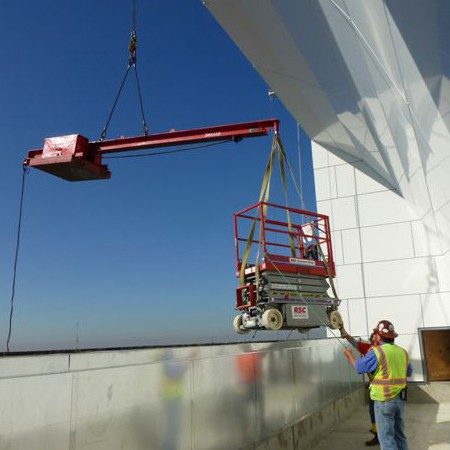
Sheedy Crane has been planning custom heavy lift services in the western U.S. and Bay Area for nearly a century. Together with our state-of-the-art equipment, engineers, field crews, and support staff, we provide innovative solutions for any rigging job imaginable. All projects are planned, engineered, and executed with the highest degree of coordination, safety, and professionalism. Using modern AutoCAD modeling programs, an in-house fabrication shop, and some of the most experienced field hands in the industry, there is nothing we can’t lift or move. Have you ever wondered what rigging is or what a rigger does? Well lucky for you, we are here to give you all the details. Let’s explore what a rigger is and what a rigger does, and how our bay area crane rental services can provide one.
The Basics
A Rigger is someone who sets up and repairs rigging at manufacturing plants, shipyards, logging yards, construction sites, and film sets. They are responsible for aligning and anchoring the machinery, attaching the loads, controlling the heavy equipment movement, and ensuring the rigging is safe.
The following job description and the required skills and qualifications are general and may differ from company to company. So, check with your crane operating company to see their job descriptions and required qualifications.
A riggers job descriptions contain a variety of functions and roles, including:
- Inspecting and preparing loads that need to be moved.
- Setting, aligning and leveling heavy equipment machinery.
- Selecting the appropriate rigging gear.
- Preparing the rigging equipment, including beams, pulleys, clamps, and bolts.
- Inspecting the rigging before its final use.
- Ensuring compliance with state and company safety procedures.
- Communicating with the rigging and construction team.
- Breaking down the rigging equipment and conducting post rigging inspections.
- Monitoring and maintaining rigging equipment.
- Maneuvering loads using heavy equipment machinery by hand.
A rigger typically needs to have or acquire these common skills and qualifications.
- High school diploma or GED
- Prior experience as a rigger
- Familiarity with Occupational Safety and Health Administration (OSHA) safety standards.
- In-depth knowledge of rigging equipment and heavy machinery.
- Excellent hearing and vision.
- Ability to work at heights and in noisy environments.
- High-level mathematical skills.
- Physical fitness and the ability to lift heavy equipment.
- Ability to work outdoors in harsh weather conditions.
Now that you know what a rigger is and what they do let’s explore what rigging is and how rigging equipment is a vital part of a heavy lift. Rigging equipment is used to successfully lift and roll loads from one destination to another. Commonly, construction and industrial sites move large, heavy, complex loads from various places at different heights and sometimes tight and confined spaces.
Particular types of components are needed which have been manufactured and crafted not to twist, buckle, deform, or collapse when strained under heavy loads. Selecting the right rigging equipment is vital otherwise, the rigger will not be able to secure and move the load effectively.
The five most common rigging hardware includes:
- Blocks and Pulleys help reduce the force required to lift heavy objects.
Various types of blocks and pulleys are available on the market, including snatch blocks, swivel blocks, single and double pulleys, and square blocks. Pulleys are typically used with rigging ropes.
- Eye Bolts come in multiple sizes and materials, so you can choose the one that best fits your needs. Eye bolts are just another anchor point for various rigging applications.
Some of the most common include shoulder eye bolts and straight eye bolts, but screw eye bolts, U-bolts, and lag eye screws are also available for special lifts.
Shoulder eye bolts are used in angular connections, while straight eye bolts are used in straight line applications.
- Rigging hooks differ in strength, capacity, and design, and many are available for different applications.
Applications differ depending on whether it is a hoist hook, lifting/rigging hook, or a sling hook.
- Wire ropes and accessories are widely used in rigging, mooring, and lifting. They are usually manufactured using stainless steel and come in classification with 6 x 19, and 6 x 37 are the most common.
Accessories include clips, thimbles, sleeves, and stops, among others.
- Stainless steel nuts use typically depends on the various rigging applications. Hex nuts, ball ends, dome nuts, wings nuts, and lifting eye nuts are some of the standard stainless-steel nuts.
Sheedy Crane: Professional Bay Area Crane Rental Services
Bay1 Area Crane Rental services provide modern techniques using novel approaches. We operate a fleet of more than 100 trucks, trailers, cranes that you can rent, and other heavy-duty lifting and hauling equipment. We are one of northern California’s leading crane, rigging, and heavy hauling contractors. Contact us today at https://www.sheedycrane.com/contact-information/ or call our corporate offices at (415) 648-7171 with any questions. We would be happy to provide you with an estimate for your project.
